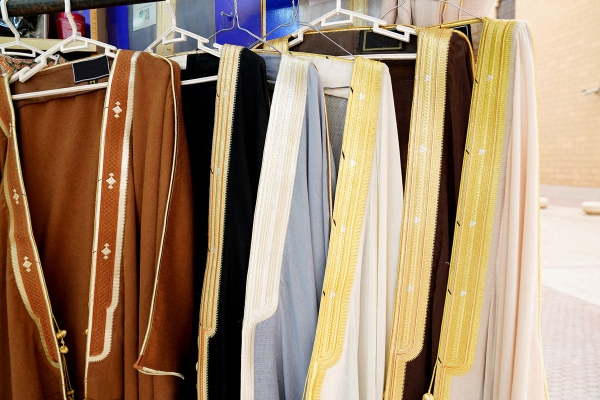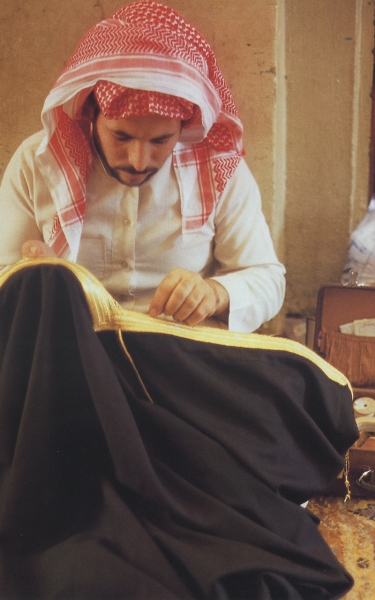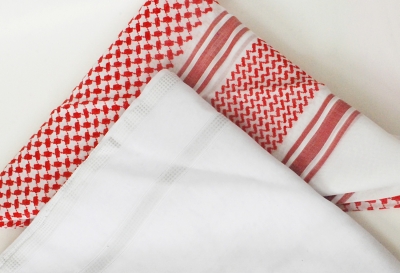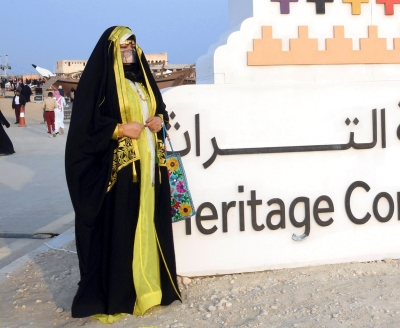

Mishlah or Bisht is one of the local names for the traditional Arabic cloak. It is a loose outer garment that is open at the front and holds cultural and social significance in the Gulf and Arab regions. Mishlah is considered a type of traditional attire in the Kingdom of Saudi Arabia, commonly worn by people during special occasions, ceremonies, and holidays.
Mishlah is often embroidered with various types of silk threads, and zari in gold, yellow, silver, white, and red colors. Different types of dark and light fabrics are used for its tailoring, depending on personal tastes.
Mishlah in Saudi culture
Mishlah is traditionally worn in the Kingdom over Thobe. It is not exclusive to the older generation; rather, it is proudly donned by young men and children. Prices vary when it is handmade by its manufacturing, details, quality and type of knitting, and the fabrics and type of Zari threads, and can range from SAR1,500 to SAR7,000. German Zari with Japanese fabrics can reach SAR3,000, but Cashmere can go up to SAR5,000 and SAR6,000. Prices can go higher.
Demand for Mishlah typically increases during special occasions, such as Eid al-Fitr, Eid al-Adha, national events, and weddings. Prices often rise before the holidays.
Manufacture of the Mishlah in the kingdom
Mishlahs produced in al-Ahsa Governorate, located east of the Kingdom, are renowned for their high-quality embroidery and meticulous handcraftsmanship. The craft of making and weaving Mishlahs has become closely associated with al-Ahsa, making it one of the leading producers and exporters of these garments within the Kingdom and across the Gulf Cooperation Council (GCC) countries. Many al-Ahsa families have mastered this craft.
The handmade Mishlah from al-Ahsa, or Hasawi Mishlah as locally called, is characterized by its meticulous weaving, incorporating silk, cotton, and wool threads. Its edges are adorned with Zari gold and silver embroidery. The sewing period ranges from ten days to six months across seven stages: Al-Tarkeeb, al-Tawq, al-Hilah, al-Burooj, al-Meqsser, al-Qitan and al-Khibanah, and, finally, al-Berdakh stage, when the Zari is being worked on and to accentuate its golden color. Five people specializing in each section of Mishlah to work on its manufacture, which include: Al-Tarkeeb al-Hila, al-Samout, al-Burooj, and Tarkeeb al-Meqsser.
In addition to al-Ahsa Governorate, there are factories that produce the Mishlah using automated methods in several provinces, such as Makkah al-Mukarramah Province and al-Madinah al-Munawwarah. There are also many sales centers. In the capital city, Riyadh, Mishlahs are sold in the historic Souq al-Zal, where they are available in a variety of colors and types to suit different needs and tastes.
Types of Mishlah fabrics
The types of fabrics used in making the Mishlah vary, with fabric choices being made based on the weather conditions. There are summer Mishlahs, known for their softness and higher prices, reflecting the quality of the threads and the time required for their weaving. Some of the types include the Hasawi, Najafi, Swiss, Durqi, Abu Ghat, Abu Ghatein, Londoner, and Japanese Mishlahs, with Hasawi Mishlahs being of the highest quality.
In contrast to the fabrics used for summer Mishlahs, winter Mishlahs are made from coarse, woolen threads to provide warmth. Some types include Booshehr Wool, Super Kashmir, and Jabrlox Wool. Spring Mishlahs, on the other hand, are of medium thickness.
Various fabrics in both dark and light shades are used in the Mishlah's sizes and details to cater to individual preferences. Some people prefer to wear certain colors, including sugary, for its calming effect, black, white, brown, and maroon.
Wearing Mishlah on official occasions
Wearing the Mishlah is considered a sign of respect during official occasions in the Kingdom. A supreme order issued on February 12, 2004, emphasized the importance of wearing the Mishlah during official events, particularly when representing the Kingdom at international events. It also stipulated that when the King or Crown Prince is present, specific Mishlah colors must be adhered to on that day.
The protocols for wearing the Mishlah in the Kingdom are based on specific colors assigned to each day of the week: the white Mishlah is worn on Friday, the brown Mishlah on Saturday, the cream or yellow Mishlah on Sunday, the burgundy Mishlah on Monday, the black Mishlah on Tuesday, the light brown or tawny Mishlah on Wednesday, and the beige Mishlah on Thursday.
Hasawi Bisht Festival
The Ministry of Culture celebrates the Hasawi Bisht as a genuine cultural symbol representing the Saudi identity through an exhibition documenting the bisht's value, live workshops on making bishts, and a celebration of national handicrafts, including Bisht weaving. In June 2022, the Ministry of Culture organized the Hasawi Bisht Festival in the Wednesday Market in al-Ahsa Governorate as part of the official opening program of the traditional Wednesday Market.
Later, in December 2023, the Heritage Commission under the Ministry of Culture held the Hasawi Bisht Festival at the historic Ibrahim Palace in al-Hufuf City, al-Ahsa Governorate. The festival featured various activities, including traditional folk performances, Saudi Ardah dance, cultural competitions, an exploration of the Bisht-making process, and demonstrations of the correct way to wear it. The "Leaders and Bisht" section showcased personal photos of the founding King Abdulaziz Bin Abdulrahman Al Saud and his sons wearing the Bisht.
Related quizzes


